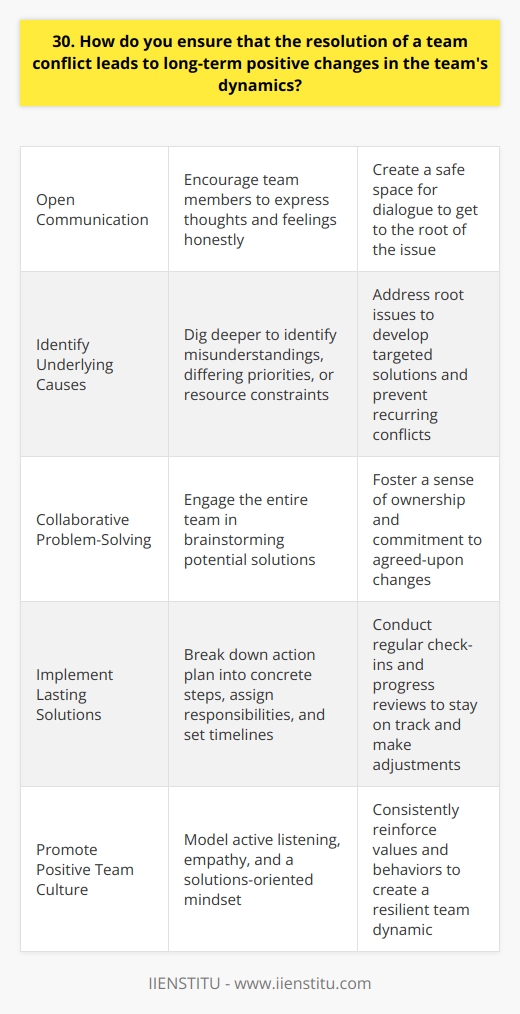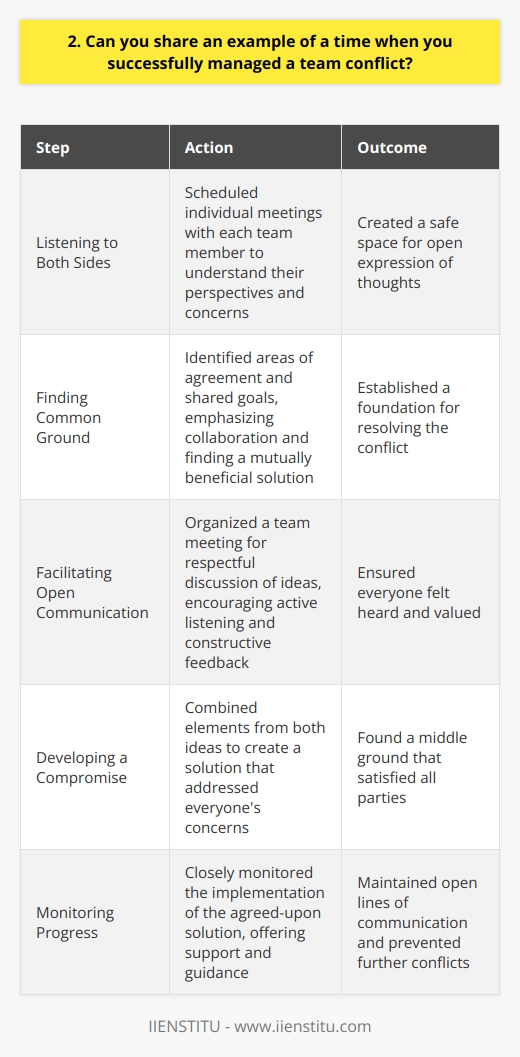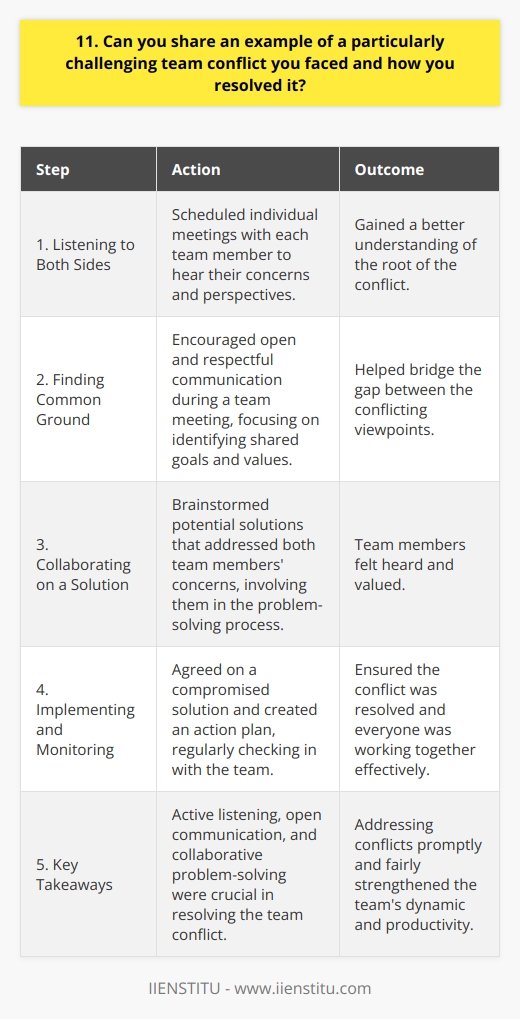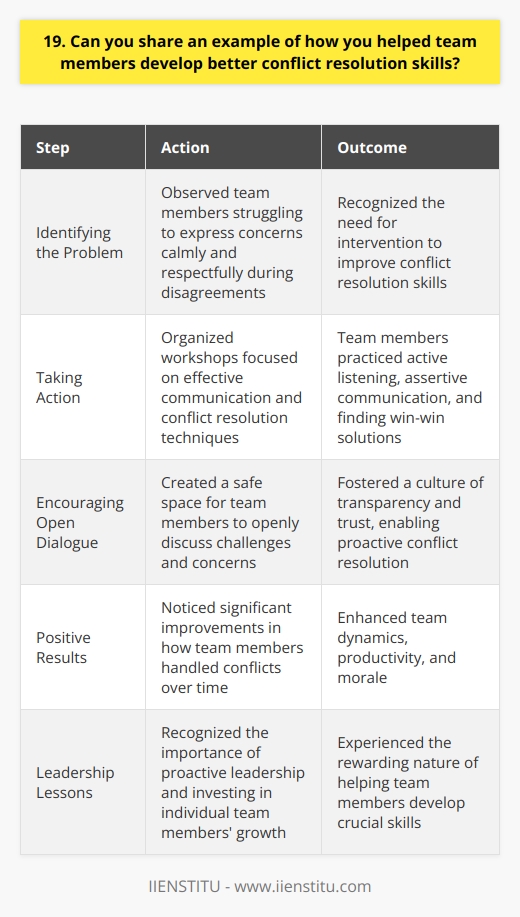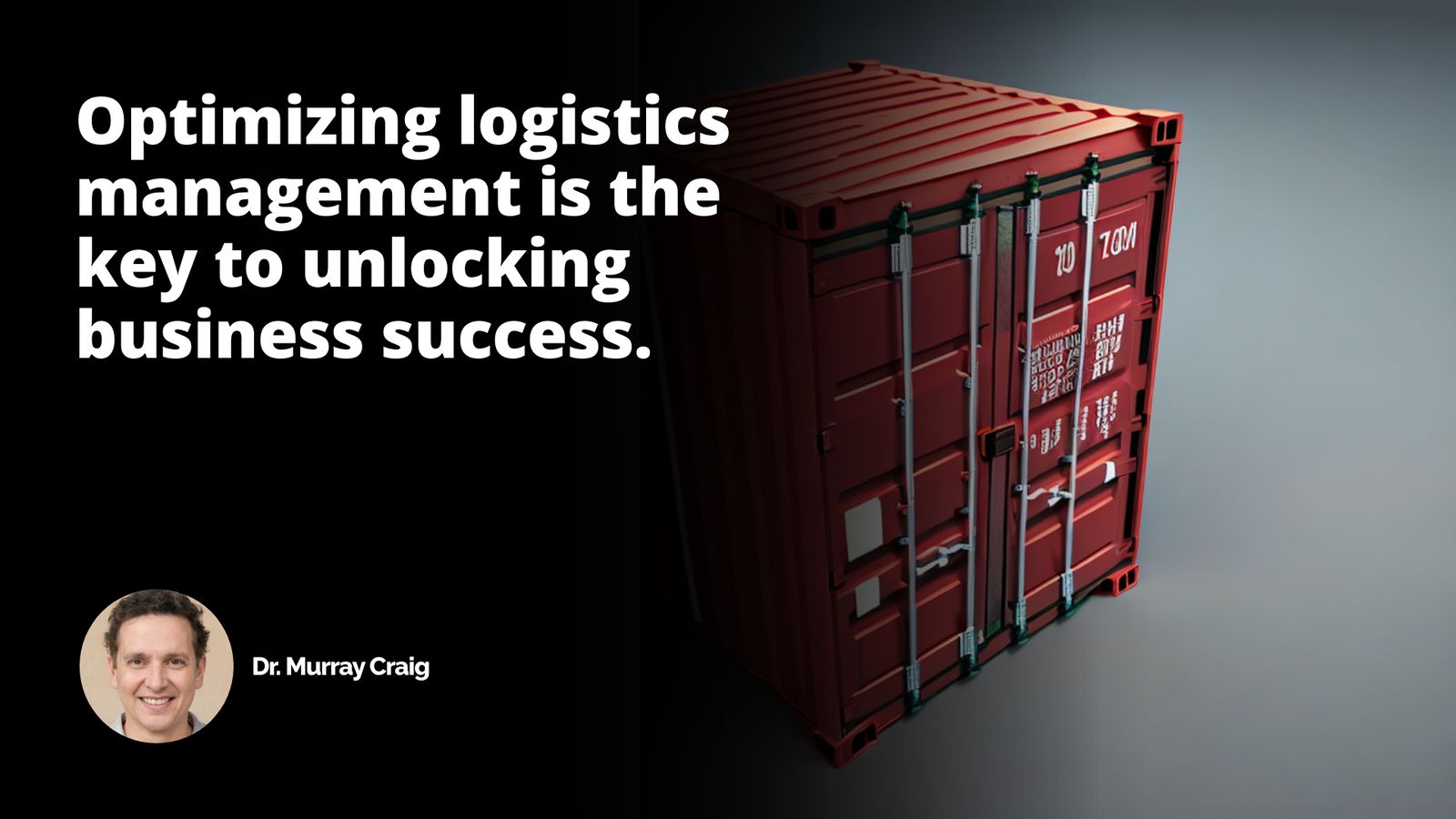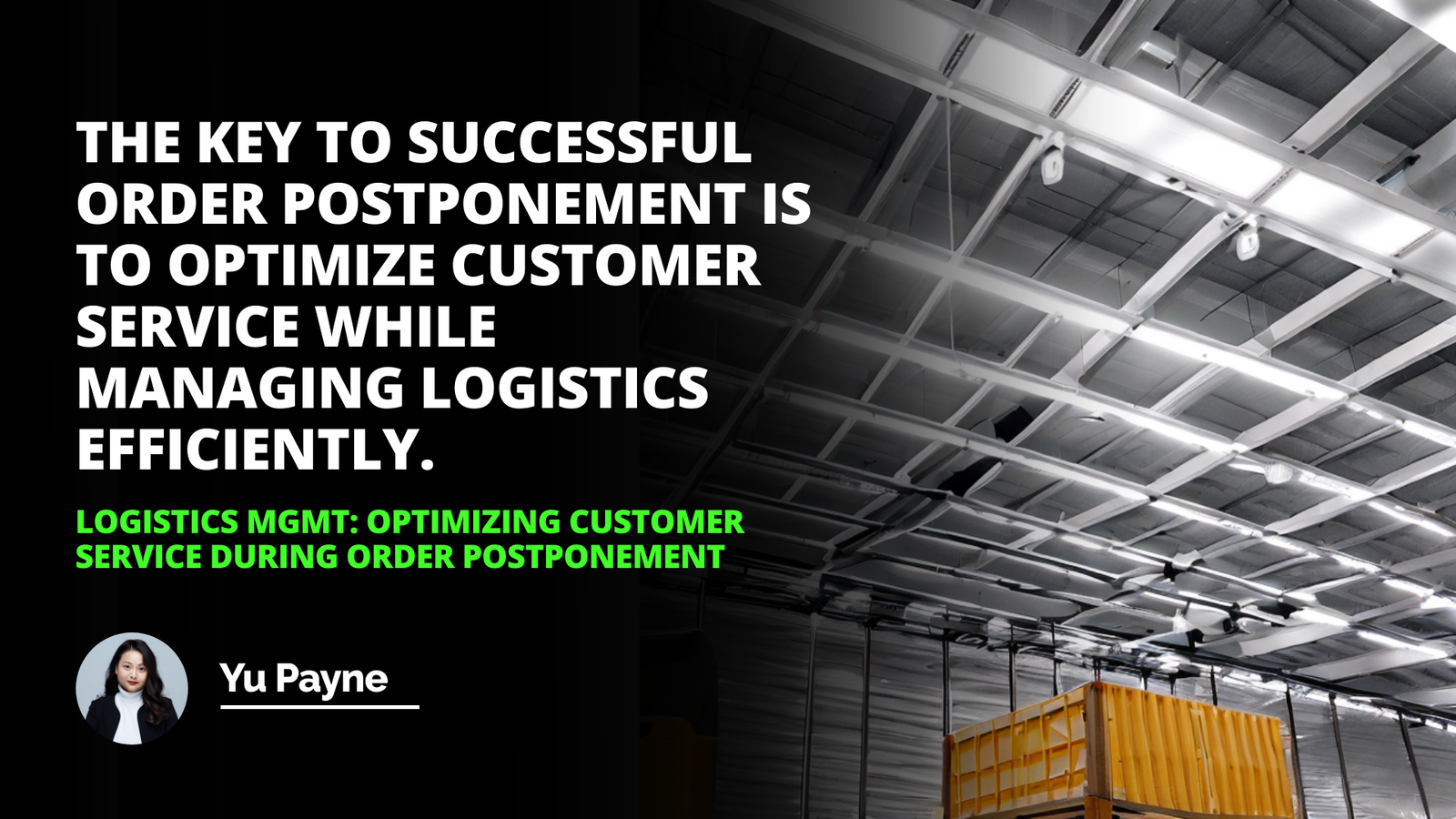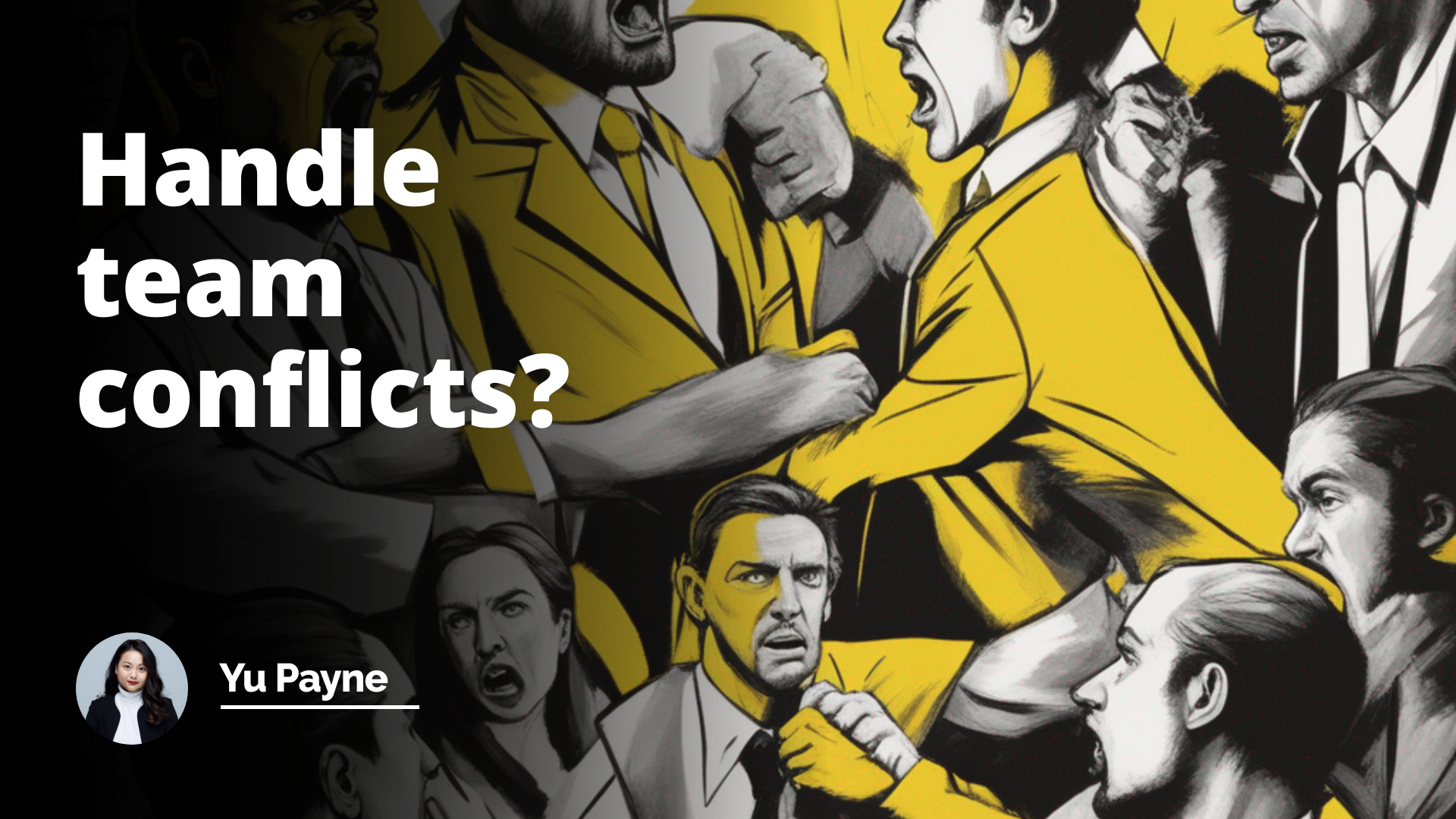
One of the most frequently asked interview questions in team-oriented roles is: "How do you handle team conflicts?" For recruiters, your answer to this question is a testament to your conflict resolution skills, team building capabilities, and leadership qualities.
Related Course: Leadership Course
This article aims to provide a detailed insight into how to effectively answer this question to help you score the ideal team-oriented role.
Why is This Interview Question Asked: Handle Team Conflicts
Being able to handle team conflicts is an essential skill in several positions, particularly those involving team leadership or management.
The question is aimed at gauging your ability to navigate situations where disagreements occur within a team setup. It is an assessment of your skills in mediation, consensus-building, empathy, and problem-solving, all crucial for maintaining a cohesive and functional team.
The Purpose of the Question
The ability to handle team conflict is fundamental to ensuring smooth operations within any organization. Personnel conflicts can derail a team’s productiveness and negatively impact the overall morale.
By asking how you deal with conflict in a team, the interviewer is exploring your capacity to preserve unity and productivity amidst disagreement.
At What Interview Level is It Asked?
Usually, you can expect this question at any interview level for positions that involve working as part of a team. It is especially pertinent in interviews for management or team leader roles, where dealing with conflict effectively is of paramount importance.
What Kind of Answer is Expected from the Candidate?
Interviewers typically seek nuanced, empathetic, and effective responses that demonstrate your understanding of conflict resolution.
Your answer should clearly outline your approach, which might involve active listening, unbiased mediation, or team-building strategies. It is also beneficial to provide examples from your past experiences where you successfully handled disagreements on your team.
Possible Answers to Consider
Active Listening and Mediation: You might recount a situation where team members had divergent views on a project’s direction. Talk about how you invited each party to share their perspective, attentively listened, and helped craft a solution reflecting the primary concerns of all parties.
Elevating the Issue: There could be scenarios where conflict resolution is beyond your purview. In such cases, discuss how you recognized this and elevated the conflict to a higher authority.
Improving Communication: An effective strategy would be describing how you foster open communication, thus preventing misunderstandings that could spark conflict. Use an example that shows your role in enhancing communication within a team.
Team-Building Activities: You could mention instances where you initiated team-building efforts to enhance understanding and camaraderie among team members - a forward-looking, preventive strategy.
Wrapping Up: Being Prepared for Conflict-Related Questions
In any interview, being prepared to tackle questions like "how would you handle a disagreement with a team member?" or "how do you resolve conflict in a team?" is crucial for proving your effectiveness as a team player.
Practice describing your strategies, including how you adapt to handle conflicts in team dynamics, with real-life examples to strengthen your position.
Remember, team conflict is often an opportunity for team growth, and demonstrating your ability to navigate and resolve such situations effectively can be a significant factor in landing your dream job.
Conflict Resolution Strategies in Team Management
Case Studies on Team Conflict Scenarios and Outcomes
Impact of Team Conflicts on Workplace Productivity
Similar interview questions:
How do you manage conflicts within your team?
What are your strategies for handling team conflicts?
Can you describe a method you use to resolve disagreements within the team?
How would you work through a conflict that arises in your team?
What steps do you take to mitigate conflicts among team members?
Could you elaborate on your approach to tackling conflicts within the team?
How do you ensure that disagreements between team members are handled effectively?
What conflict resolution techniques do you apply when managing your team?
How would you deal with a situation where there is conflict within your team?
Can you provide an example of a time when you handled a conflict between team members?
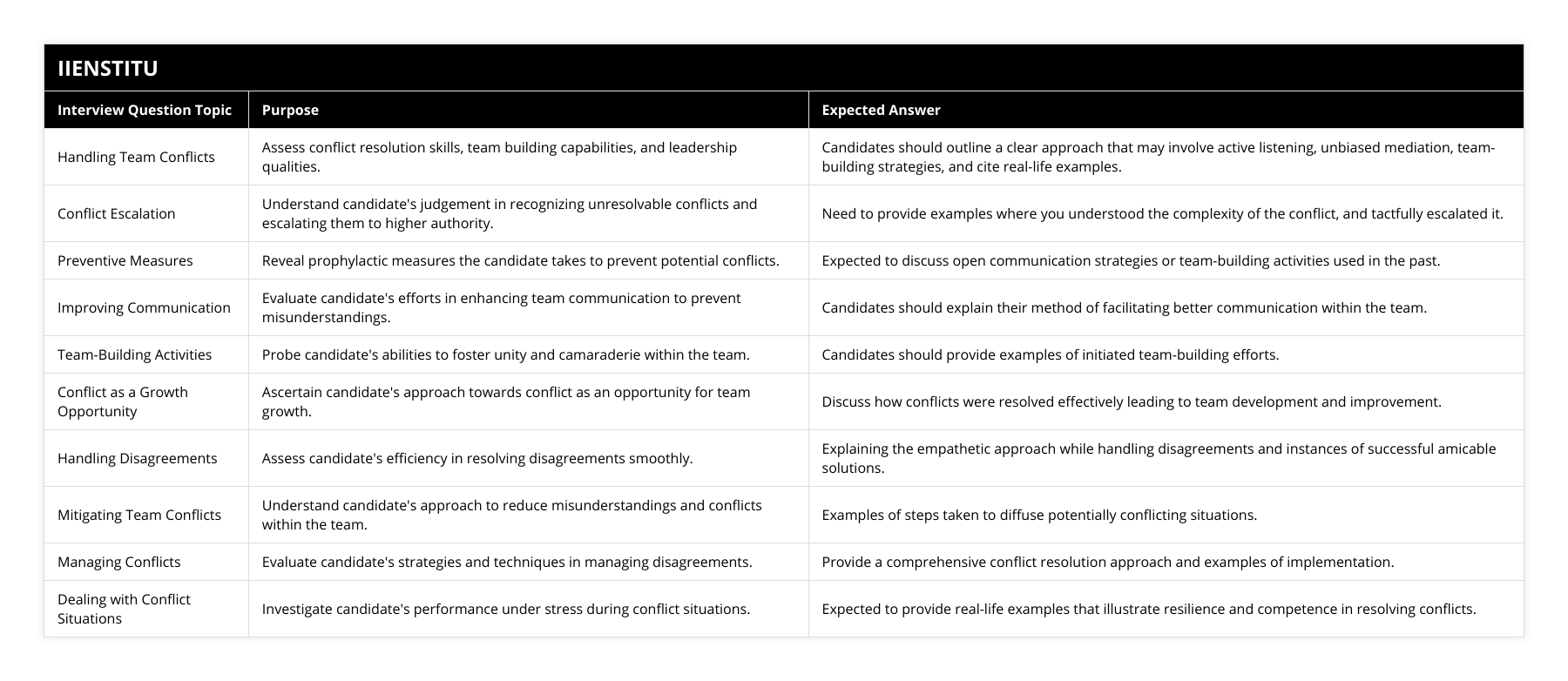
Frequently Asked Questions
1. How do you approach resolving conflicts within your team?
When it comes to resolving conflicts within a team, I believe in a proactive and empathetic approach. Throughout my professional career, I've learned that open communication is key to maintaining a harmonious work environment.
Identifying the Root Cause
The first step I take is to understand the source of the conflict. I listen attentively to each team member's perspective, ensuring everyone feels heard and valued. By gathering all the facts, I can better grasp the underlying issues.
Facilitating Open Dialogue
Next, I bring the conflicting parties together for a constructive discussion. I create a safe space where they can express their concerns and feelings openly. As a neutral mediator, I guide the conversation towards finding common ground and mutually beneficial solutions.
Encouraging Empathy and Collaboration
I encourage team members to put themselves in each other's shoes. By fostering empathy, I help them understand different viewpoints and find ways to collaborate effectively. I believe that when people feel understood, they're more likely to work together towards a resolution.
Focusing on Solutions
Throughout the conflict resolution process, I keep the focus on finding practical solutions. I ask questions that prompt creative thinking and encourage the team to brainstorm ideas. By involving everyone in the problem-solving process, I ensure that the final resolution is one that all parties can accept and commit to.
Learning and Growth
I view conflicts as opportunities for growth and learning. Once a resolution is reached, I work with the team to reflect on the experience and identify areas for improvement. By continuously learning from these situations, we can strengthen our communication skills and build a more resilient team dynamic.
At the end of the day, my goal is to help the team move forward positively. By approaching conflicts with empathy, open-mindedness, and a solutions-oriented mindset, I believe we can not only resolve disputes but also foster a strong sense of unity and collaboration within the team.

3. What strategies do you use to prevent conflicts from arising in your team?
As a team leader, I believe that open communication and active listening are key to preventing conflicts. I encourage my team members to voice their concerns and ideas openly, and I make sure to listen attentively and respond thoughtfully. This creates an environment of trust and collaboration, where everyone feels heard and valued.
Establishing Clear Roles and Responsibilities
Another strategy I use is to establish clear roles and responsibilities for each team member. When everyone knows what is expected of them and how their work fits into the bigger picture, there is less room for misunderstandings and conflicts. I make sure to discuss these roles and responsibilities regularly, especially when new projects or tasks arise.
Encouraging Teamwork and Collaboration
I also strongly believe in the power of teamwork and collaboration. When team members work together towards a common goal, they are less likely to engage in conflicts. I encourage my team to collaborate and help each other out whenever possible. We have regular team-building activities and meetings where we can bond and strengthen our relationships.
Leading by Example
Finally, I believe that as a leader, it's important to lead by example. I strive to maintain a positive attitude, even in challenging situations, and I always treat my team members with respect and professionalism. By modeling the behavior I expect from my team, I set the tone for a harmonious and productive work environment.
In my experience, these strategies have been effective in preventing conflicts and fostering a positive team dynamic. I'm confident that I can bring these skills to your organization and contribute to a collaborative and successful team.
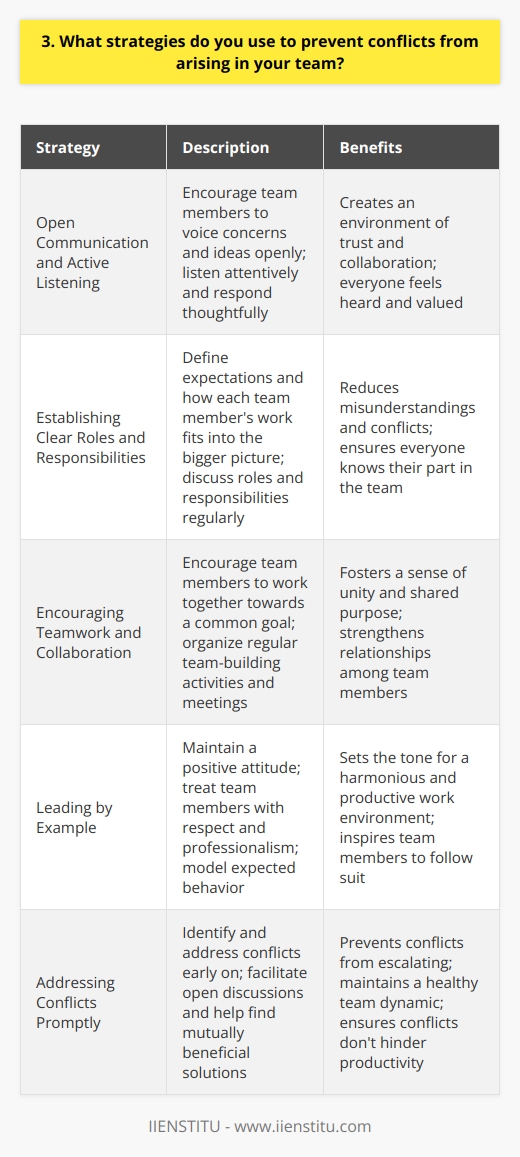
4. How do you foster a positive and collaborative team environment?
I believe that fostering a positive and collaborative team environment is essential for success. In my experience, the key is to lead by example and create an atmosphere of trust and respect. I make a point to actively listen to my team members and value their input. Encouraging open communication and idea-sharing helps everyone feel heard and appreciated.
Building Strong Relationships
Taking the time to get to know my colleagues on a personal level is important to me. I enjoy organizing team-building activities like group lunches or fun outings. These informal interactions help strengthen relationships and improve collaboration back at the office. We're able to work together more effectively when we understand each other's strengths, weaknesses, and communication styles.
Promoting a Growth Mindset
I'm a big believer in continuous learning and improvement. I strive to create an environment where it's okay to make mistakes as long as we learn from them. Encouraging my team to take on new challenges and develop their skills keeps everyone engaged and motivated. Celebrating both individual and group achievements is also crucial for maintaining positive morale.
Leading with Empathy
At the end of the day, we're all human. I try to approach conflict resolution and performance issues with empathy and understanding. Taking the time to really listen and see things from others' perspectives helps me find win-win solutions. I've found that when team members feel supported and valued, they're more likely to go the extra mile.
By consistently modeling these behaviors and attitudes, I aim to cultivate a team culture of positivity, collaboration, and growth. I'm excited to bring this approach to your organization and contribute to a thriving workplace.

5. What do you consider to be the main causes of conflicts within a team?
In my experience, conflicts within a team can arise from various sources. One major cause is a lack of clear communication among team members. When expectations, roles, and responsibilities are not effectively communicated, misunderstandings and disagreements can easily occur.
Differing Priorities and Goals
Another common cause of team conflicts is when individuals have conflicting priorities or goals. Each team member may have their own agenda, leading to a clash of interests. It's crucial for the team to align their objectives and work towards a shared vision.
Personality Clashes and Ego
Personality differences can also contribute to conflicts within a team. Some individuals may have strong egos or dominant personalities that clash with others. It's important to foster an environment of mutual respect and encourage open-mindedness.
Resource Scarcity and Competition
When resources are limited, such as time, budget, or personnel, it can create competition and tension among team members. Effective resource allocation and collaboration become essential to mitigate conflicts in such situations.
Lack of Trust and Transparency
Trust is the foundation of any successful team. When there is a lack of trust or transparency, it breeds suspicion and conflicts. Building a culture of openness, honesty, and accountability can help prevent and resolve conflicts.
In my view, addressing these root causes requires strong leadership, open communication channels, and a commitment to teamwork. By fostering a positive team dynamic and addressing issues proactively, conflicts can be minimized and resolved effectively.
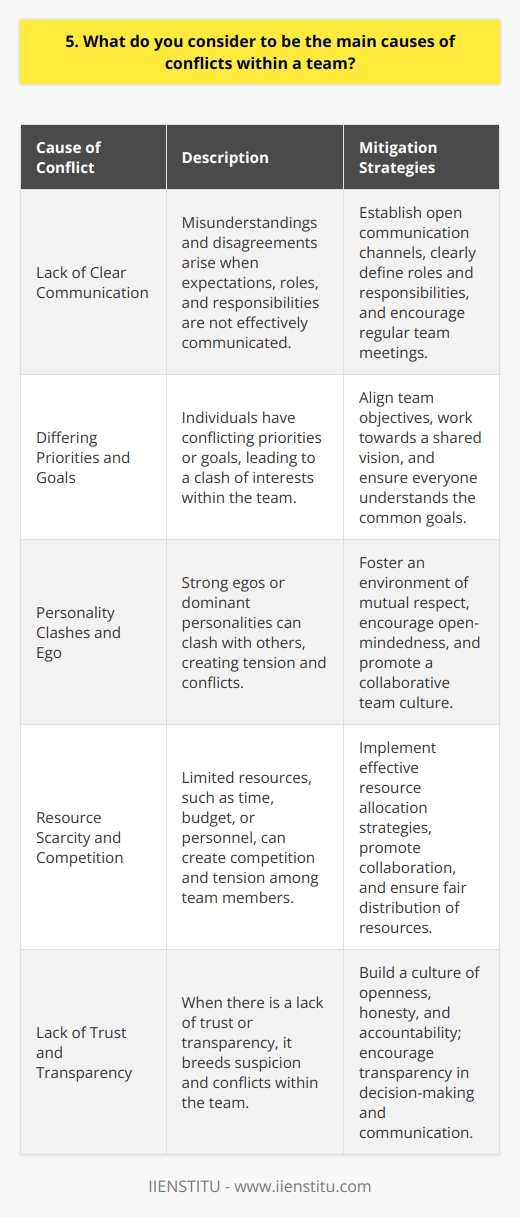
6. How do you handle a situation where two team members are not getting along?
When two team members are not getting along, I first try to understand the root cause of the conflict. I speak with each person privately to hear their perspective and concerns. Active listening is key here.
Facilitating a Discussion
Next, I bring both parties together for an open, honest discussion. I act as a neutral mediator, ensuring each person feels heard and respected. The goal is to find common ground and a mutually agreeable solution.
I encourage them to focus on the facts and issues, not personal attacks. I guide the conversation towards constructive problem-solving rather than dwelling on past grievances. Maintaining a forward-looking, solution-oriented approach is essential.
Follow Up and Support
After the initial discussion, I check in regularly with both team members. I make sure they're adhering to the agreed-upon solution and that tensions are easing. If needed, I offer additional support or resources, like communication workshops or team-building exercises.
Throughout the process, I remain patient, empathetic, and non-judgmental. Resolving conflicts takes time and effort from all involved. As a leader, my role is to facilitate understanding and cooperation, so the team can move forward positively.
I once mediated a conflict between two project managers with clashing work styles. Through open dialogue and compromise, we developed a system for them to collaborate effectively while respecting their differences. The experience taught me the power of active listening and creative problem-solving in maintaining team harmony.
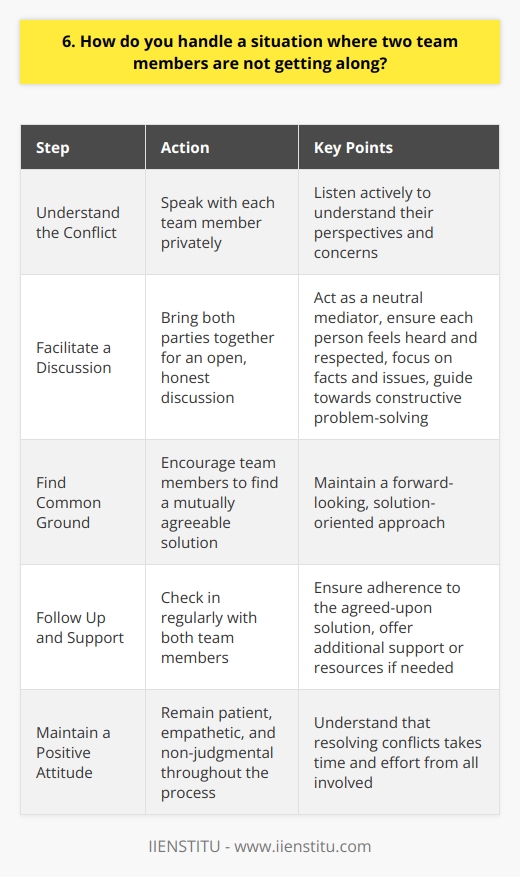
7. Can you describe a time when you had to mediate a conflict between team members?
In my previous role as a project manager, I had to mediate a conflict between two team members. They had different opinions on how to approach a critical task, which led to a heated argument.
Listening to Both Sides
I first sat down with each team member separately to understand their perspectives. I listened actively and empathetically, making sure they felt heard and valued. It was important to gather all the facts before making any judgments.
Finding Common Ground
After hearing both sides, I realized they had more in common than they thought. They both wanted what was best for the project, but had different ideas on how to get there. I pointed out their shared goals and encouraged them to focus on those.
Facilitating a Productive Discussion
I then brought the team members together for a face-to-face discussion. I set ground rules, like no interrupting and using "I" statements. I facilitated the conversation, guiding them to express their views respectfully and find a mutually agreeable solution.
Reaching a Compromise
Through open and honest communication, we were able to reach a compromise. They agreed to blend elements of both their approaches, creating a solution that satisfied everyone. It took some give and take, but in the end, the team was stronger for it.
Mediating this conflict taught me the importance of active listening, finding common ground, and facilitating productive discussions. By bringing the team members together and guiding them to a compromise, we were able to move forward successfully. It was a challenging situation, but I'm proud of how I handled it and the results we achieved.
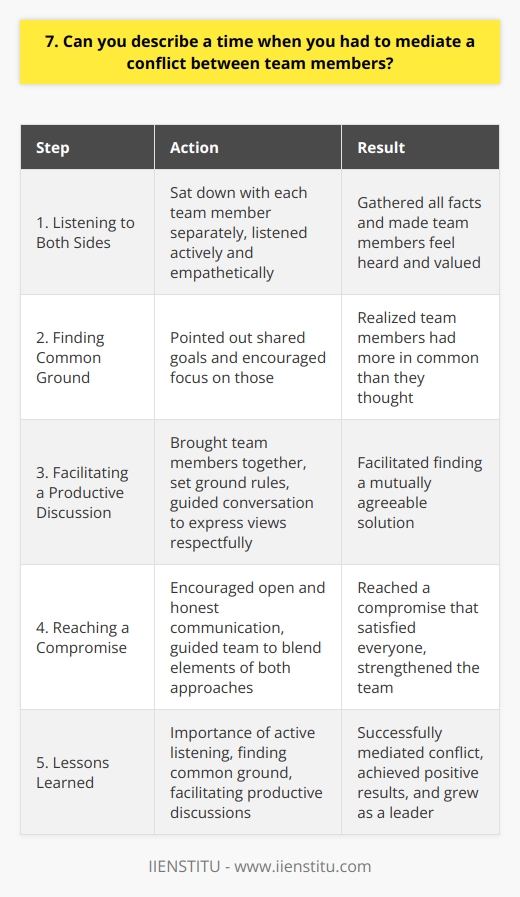
8. How do you ensure that conflicts are addressed promptly and effectively?
As a professional, I understand the importance of addressing conflicts promptly and effectively in the workplace. Here are some strategies I use to ensure conflicts are resolved in a timely and efficient manner:
Identify the Issue Early
The first step is to recognize when a conflict is brewing. I stay attuned to subtle changes in team dynamics and communication. If I sense tension or disagreement, I address it immediately before it escalates into a bigger problem.
Listen Actively and Empathetically
When a conflict arises, I make it a point to listen carefully to all parties involved. I try to understand each person's perspective, concerns, and needs. By showing empathy and validating their feelings, I create a safe space for open dialogue.
Facilitate Open Communication
I encourage team members to express their thoughts and opinions respectfully. I guide the conversation, ensuring everyone has a chance to speak without interruption. By promoting honest and transparent communication, misunderstandings can be cleared up quickly.
Find Common Ground
Even in the midst of conflict, I believe there are always points of agreement. I help the team identify shared goals and values. By focusing on these commonalities, we can start building a foundation for resolution.
Brainstorm Solutions Together
Once everyone feels heard and understood, I engage the team in collaborative problem-solving. We generate ideas and explore potential solutions together. By involving everyone in the process, buy-in and commitment to the resolution are stronger.
Follow Up and Monitor Progress
After a resolution is reached, I don't consider the conflict fully resolved. I follow up with team members individually to ensure they feel satisfied with the outcome. I also keep an eye on the situation to catch any lingering issues or resentments early on.
By approaching conflicts with empathy, openness, and a solution-focused mindset, I have been successful in resolving even the most challenging disputes. I believe that conflicts, when handled well, can actually strengthen team bonds and lead to greater innovation and productivity.
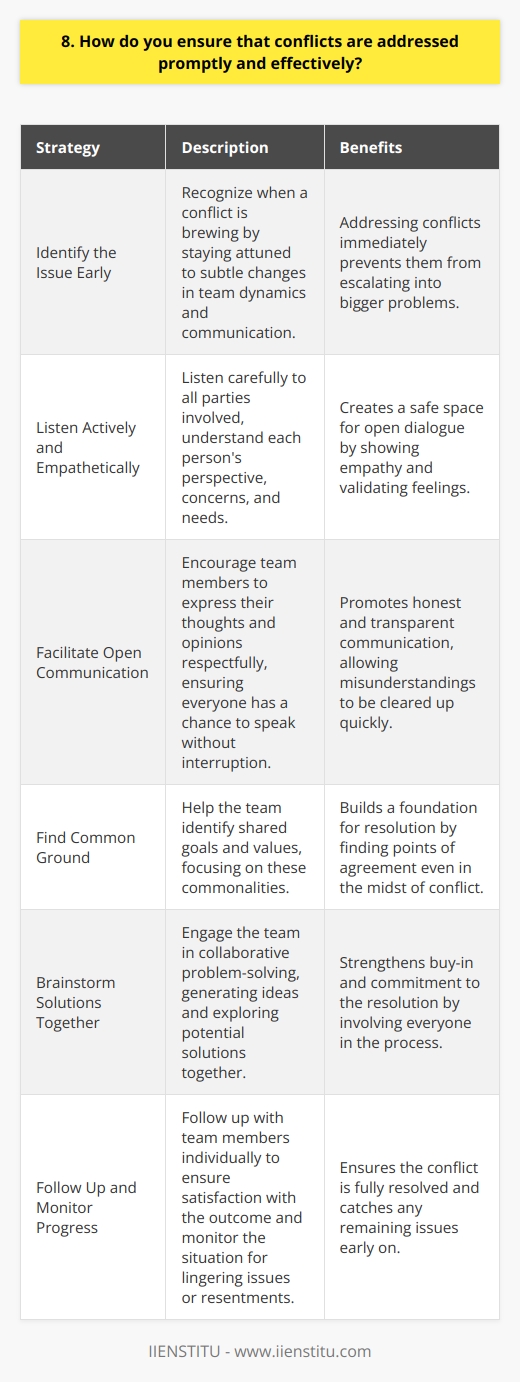
9. What steps do you take to maintain team morale during a conflict?
I believe that maintaining team morale during a conflict is crucial for the success of any project. Here are some steps I take to keep the team's spirits high:
Encourage Open Communication
I create an environment where everyone feels comfortable expressing their thoughts and concerns. I listen actively and empathize with their perspectives, even if I don't agree with them. By fostering open dialogue, we can address issues before they escalate into full-blown conflicts.
Example:
In my previous job, two team members had a disagreement over the direction of a project. I sat down with them individually to understand their viewpoints and then brought them together to find a compromise. By facilitating an honest discussion, we were able to resolve the conflict and move forward as a team.
Focus on the Common Goal
When conflicts arise, it's easy to get caught up in personal differences and lose sight of the bigger picture. I remind my team of our shared objectives and the importance of working together to achieve them. By focusing on what unites us rather than what divides us, we can maintain a positive and productive atmosphere.
Lead by Example
As a leader, I set the tone for the team. I remain calm and professional, even in the face of adversity. I avoid engaging in gossip or negativity and instead focus on finding solutions. By modeling the behavior I expect from my team, I inspire them to do the same.
Maintaining team morale during a conflict is not always easy, but it's essential for the long-term success of any organization. By encouraging open communication, focusing on common goals, and leading by example, I strive to create a positive and productive work environment where everyone can thrive.
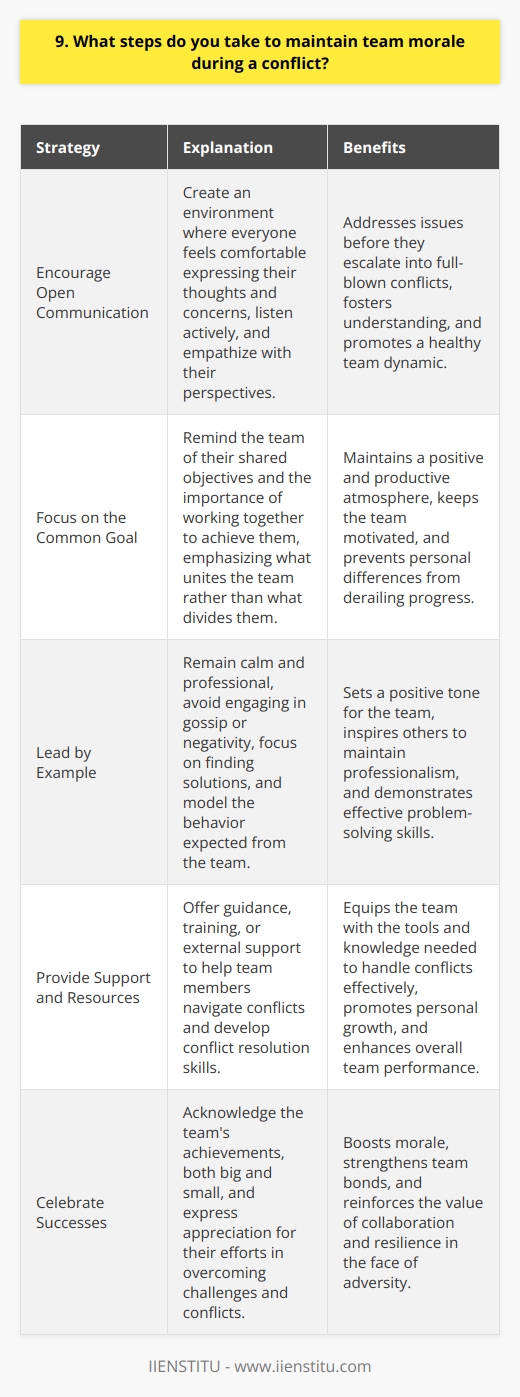
10. How do you encourage open communication and feedback within your team to prevent conflicts?
I believe that open communication and feedback are essential for preventing conflicts within a team. I encourage this by fostering a culture of trust, respect, and psychological safety where everyone feels comfortable speaking up.
Leading by Example
As a leader, I model the behavior I want to see. I openly share my thoughts, concerns, and feedback with the team. By being vulnerable and transparent myself, it shows them it's okay to do the same.
Regular Check-Ins
I hold regular one-on-one meetings with each team member. These informal chats give them a safe space to share how they're doing, voice any issues, and get guidance. It helps me keep a pulse on dynamics and spot potential problems early.
Team Retrospectives
After projects, we hold team retrospectives to reflect on what went well and what could be improved. I make sure everyone has a chance to share their perspective. We focus on learning, not blaming. These sessions often surface helpful insights for smoother collaboration next time.
Positive Reinforcement
Whenever someone shares constructive feedback or brings up a tough issue, I thank them for speaking up. Positive reinforcement encourages more of that candid communication. People start to see giving and receiving feedback as normal and valuable, not something to fear.
With consistent effort, these practices help create an open team culture that prevents conflicts from festering. Issues get brought to light and resolved collaboratively instead. The team learns how to communicate through challenges directly with empathy and respect.
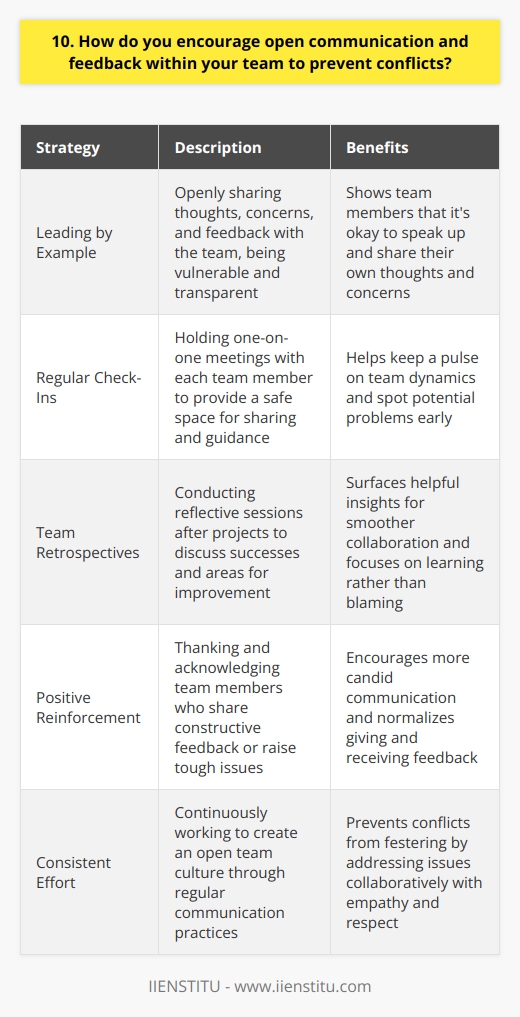
12. How do you balance the needs and perspectives of different team members during a conflict?
When faced with a conflict between team members, I prioritize active listening and understanding each person's perspective. I believe that open communication is key to finding common ground and resolving disagreements.
Seek to Understand
I start by having one-on-one conversations with each team member involved to fully grasp their viewpoints and concerns. By giving everyone a chance to express themselves, I can better appreciate the full scope of the issue.
Find Common Goals
Despite differing opinions, I've found that most conflicts arise from team members ultimately wanting what's best for the project. I try to highlight these shared goals and values to foster a spirit of collaboration over competition.
Brainstorm Solutions Together
Once everyone feels heard and aligned on objectives, I bring the team together to brainstorm potential compromises and solutions. Encouraging a diversity of ideas often reveals new approaches that address multiple needs.
Clarify Roles and Responsibilities
Many team conflicts stem from unclear expectations around who is doing what. I've learned that clearly defining and documenting each person's role and responsibilities can prevent misunderstandings from arising in the first place.
Ultimately, balancing team members' needs during a conflict requires patience, empathy, and creativity. But when done well, working through these challenges together makes the team stronger and more unified moving forward.
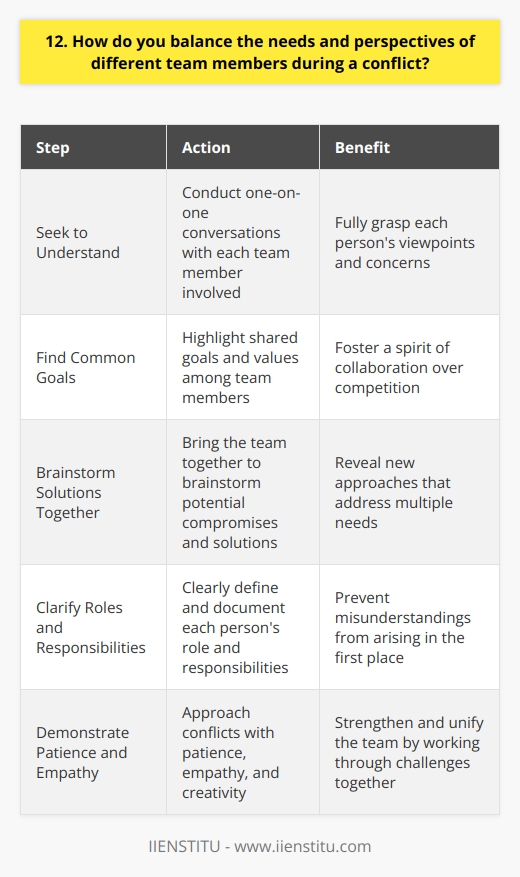
13. What do you believe are the key skills required for effective conflict resolution in a team setting?
I believe effective conflict resolution in a team setting requires several key skills. In my experience, active listening is crucial. You must give your full attention to understand each team member's perspective and concerns.
Communication Skills
Clear communication is essential. I always strive to express my thoughts and ideas in a calm, respectful manner. It's important to avoid aggressive or confrontational language that can escalate tensions.
Emotional Intelligence
Emotional intelligence is another vital skill. I try to be aware of my own emotions and empathize with others. By recognizing and validating team members' feelings, you can build trust and rapport.
Problem-Solving Mindset
Approaching conflicts with a problem-solving mindset is key. I focus on finding mutually beneficial solutions rather than assigning blame. Brainstorming sessions can generate creative ideas that address everyone's needs.
Patience and Perseverance
Resolving conflicts often requires patience and perseverance. Some issues may not be solved in one meeting. I'm willing to have ongoing discussions and follow up to ensure long-term harmony.
Ultimately, I believe treating team members with respect, empathy, and a collaborative spirit is the foundation for effective conflict resolution. By honing these skills, teams can turn conflicts into opportunities for growth and strengthened relationships.

14. How do you handle a situation where a team member is consistently causing conflicts?
When dealing with a team member who consistently causes conflicts, I believe in addressing the issue directly and privately. I would schedule a one-on-one meeting with the individual to discuss the situation and listen to their perspective. It's important to approach the conversation with empathy and an open mind.
Identifying the Root Cause
During our meeting, I would try to understand the underlying reasons behind their behavior. Are they feeling stressed or overwhelmed? Is there a lack of clarity in their role or responsibilities? By identifying the root cause, we can work together to find a solution.
Setting Clear Expectations
I would clearly communicate the team's expectations and the impact of their behavior on others. Together, we would set specific goals and guidelines to improve their communication and collaboration skills. I believe in providing support and resources to help them succeed.
Monitoring Progress and Providing Feedback
After our initial discussion, I would closely monitor their progress and provide regular feedback. Praising improvements and addressing any setbacks promptly is crucial. If the conflicts persist, I would involve HR and explore further actions to maintain a positive team dynamic.
Leading by Example
Throughout the process, I would lead by example, demonstrating respectful communication and conflict resolution skills. By fostering a culture of open dialogue and collaboration, I believe we can overcome challenges and build a stronger, more cohesive team.
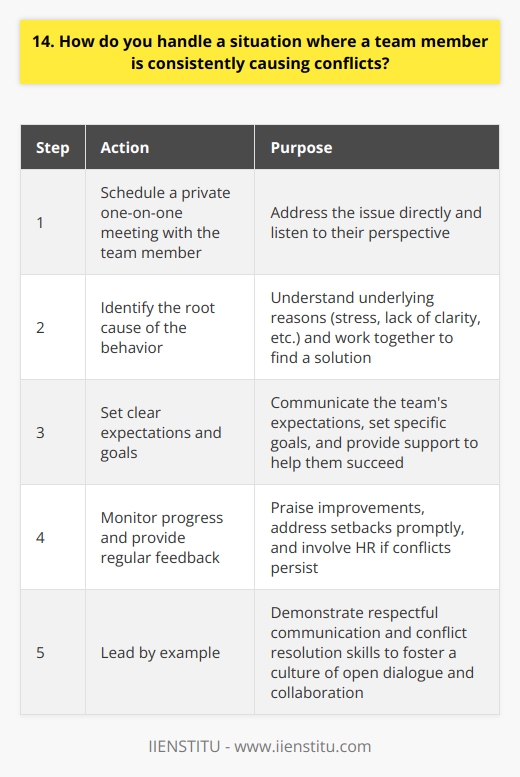
15. Can you describe your approach to facilitating a constructive dialogue between conflicting team members?
When faced with conflict between team members, I prioritize open communication and active listening. I believe that everyone should have the opportunity to express their concerns and perspectives without fear of judgment or retaliation.
Creating a Safe Space
To facilitate a constructive dialogue, I first aim to create a safe and neutral environment where all parties feel comfortable sharing their thoughts. This might involve finding a private meeting room or even suggesting a walk outside to help diffuse any tension.
Active Listening and Empathy
During the discussion, I encourage each team member to share their side of the story while practicing active listening myself. I ask clarifying questions and repeat back key points to ensure I fully understand their perspective. Throughout the process, I try to remain empathetic and validate each person's feelings, even if I don't necessarily agree with their stance.
Identifying Common Ground
Once everyone has had a chance to speak, I help the team identify any common ground or shared goals. Often, conflicts arise due to misunderstandings or miscommunications rather than fundamental disagreements. By focusing on areas of agreement, we can start to build a foundation for resolution.
Brainstorming Solutions
With a clearer understanding of each person's perspective and any common objectives, I guide the team in brainstorming potential solutions. I encourage everyone to contribute ideas and remain open-minded. We evaluate each option together, considering the pros and cons and how well it aligns with our team's goals and values.
Throughout the process, I strive to remain neutral and avoid taking sides. My role is to facilitate the conversation, not impose my own opinion. By creating a safe space for open dialogue, practicing active listening and empathy, identifying common ground, and brainstorming solutions together, I believe most conflicts can be resolved in a way that strengthens the team's bond and productivity.
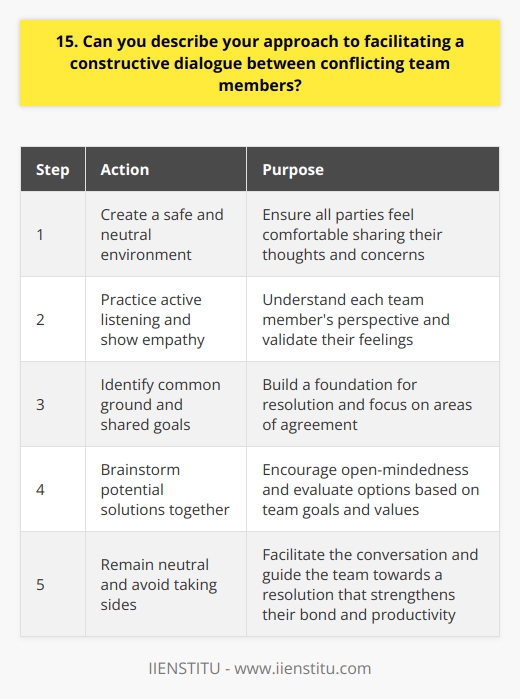
16. How do you ensure that all team members feel heard and respected during a conflict?
When conflicts arise within a team, it's crucial to ensure that everyone feels heard and respected. I believe that active listening is key to achieving this goal. By giving each team member my full attention and concentrating on understanding their perspective, I demonstrate that their input is valued.
Encouraging Open Communication
I encourage open communication by creating a safe space where team members can express their thoughts and feelings without fear of judgment. I ask questions to gain clarity and show genuine interest in their ideas. By fostering an environment of trust and openness, team members are more likely to share their concerns and work together towards a resolution.
Mediating Discussions
As a mediator during conflicts, I strive to maintain a neutral stance and ensure that everyone has an equal opportunity to speak. I summarize key points and rephrase statements to ensure that each person's message is accurately conveyed. By facilitating respectful dialogue, I help the team find common ground and work towards a mutually beneficial solution.
Leading by Example
I believe in leading by example when it comes to promoting respect and inclusivity. I make a conscious effort to treat everyone with kindness and empathy, even in challenging situations. By modeling active listening and respectful communication, I set the tone for how conflicts should be handled within the team.
In my experience, taking these steps helps create a positive team dynamic where everyone feels valued and heard. It's not always easy, but by prioritizing open communication and mutual respect, conflicts can be transformed into opportunities for growth and strengthened collaboration.
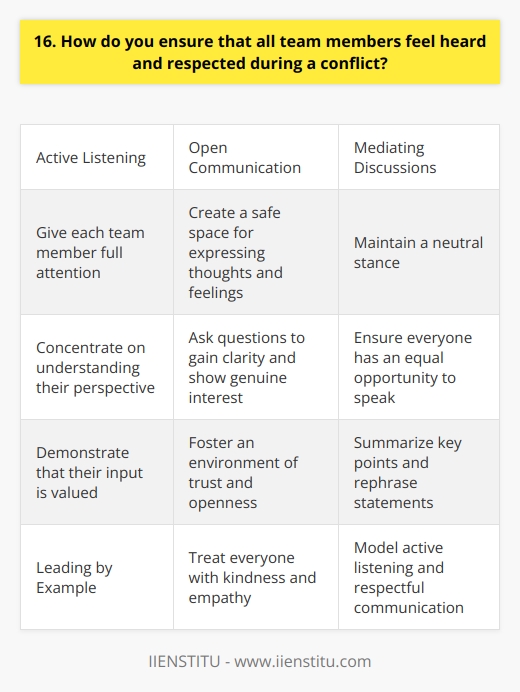
17. What techniques do you use to de-escalate tensions and find common ground during a team conflict?
When tensions arise during a team conflict, I take a proactive approach to de-escalate the situation. I start by actively listening to each team member's concerns and perspectives. This helps me understand the root cause of the conflict and find common ground.
Encouraging Open Communication
I encourage open and honest communication among team members. I create a safe space where everyone feels heard and respected. By promoting a culture of transparency, we can address issues before they escalate into major conflicts.
Focusing on Common Goals
I remind the team of our shared objectives and the importance of working together. By shifting the focus from individual differences to our collective goals, we can find a way to collaborate effectively.
Facilitating Compromise
When team members have opposing views, I help them find a middle ground. I encourage them to be open to compromise and find solutions that benefit everyone. It's not about one person winning, but the team succeeding together.
Leading by Example
As a team leader, I set the tone for how conflicts are handled. I remain calm, objective, and respectful, even in challenging situations. By modeling this behavior, I inspire my team to do the same.
Resolving team conflicts is never easy, but with the right approach, it can be done. By actively listening, encouraging open communication, focusing on common goals, facilitating compromise, and leading by example, I help my team navigate conflicts and come out stronger on the other side.

18. How do you deal with a team member who is resistant to resolving a conflict?
When dealing with a team member resistant to resolving a conflict, I believe in open and honest communication. I would first seek to understand their perspective and the reasons behind their resistance. Active listening is key here.
Finding Common Ground
Once I have a clear understanding of their viewpoint, I would try to find common ground. I would emphasize the shared goals and objectives of the team. By focusing on what unites us, rather than what divides us, we can start to build bridges.
Proposing Solutions
Next, I would propose potential solutions that take into account both parties' concerns. I would present these ideas in a non-threatening, collaborative manner. The aim is to find a win-win solution that everyone can get behind.
Leading by Example
Throughout the process, I would strive to lead by example. I would remain calm, professional, and focused on finding a resolution. By modeling the behavior I expect from others, I can set the tone for a productive dialogue.
Escalating if Necessary
If, despite my best efforts, the team member remains resistant, I would escalate the issue to a higher authority. However, this would be a last resort. I believe most conflicts can be resolved through open communication and a willingness to compromise.
At the end of the day, we're all on the same team. By working together, we can overcome any obstacle and achieve great things.
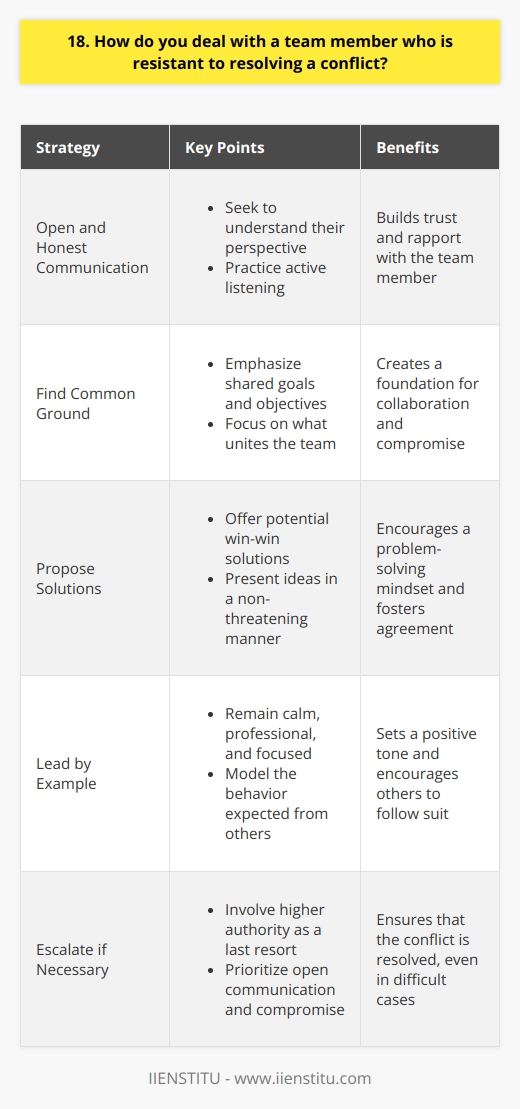
20. How do you maintain your own objectivity and fairness when managing team conflicts?
When managing team conflicts, I always strive to maintain objectivity and fairness. This involves actively listening to all perspectives without judgment or bias. I encourage open communication and create a safe space for team members to express their concerns.
Gathering Information
To fully understand the situation, I gather information from all parties involved. This helps me see the bigger picture and identify the root causes of the conflict. I ask questions to clarify details and ensure everyone feels heard.
Facilitating Discussion
Once I have a clear understanding, I facilitate a discussion between the conflicting team members. I guide the conversation, ensuring it remains respectful and productive. Together, we explore potential solutions that address everyone's needs and concerns.
Making Unbiased Decisions
When it comes time to make a decision, I consider all the facts and perspectives objectively. I set aside any personal opinions or biases and focus on what's best for the team as a whole. I communicate my decision clearly, explaining the reasoning behind it.
Following Up
After resolving the conflict, I follow up with the team to ensure the solution is working. I check in regularly to see how everyone is doing and address any lingering concerns. By staying involved, I can catch and resolve any new issues before they escalate.
Throughout the process, I remain calm, empathetic, and impartial. By modeling this behavior, I create a team culture of open communication, respect, and collaboration. Conflicts become opportunities for growth and strengthening relationships, rather than divisive events.
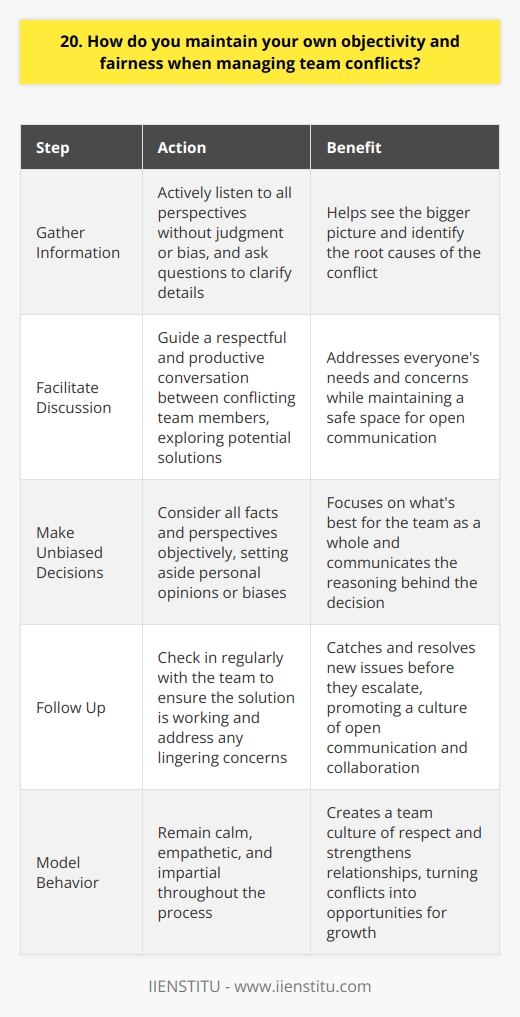
21. What do you consider to be the most important factors in creating a conflict-resistant team culture?
I believe that open communication is the foundation of a conflict-resistant team culture. When team members feel comfortable expressing their thoughts and concerns, misunderstandings and tensions are less likely to arise. It's crucial to create an environment where everyone feels heard and respected.
Encourage Diversity and Inclusivity
Embracing diversity and promoting inclusivity is another key factor. When team members come from different backgrounds and perspectives, it can lead to more creative problem-solving and innovation. By valuing and celebrating these differences, we foster a sense of belonging and unity within the team.
Lead by Example
As a leader, I believe in setting the tone for the team. If I demonstrate respect, empathy, and a willingness to collaborate, it encourages others to do the same. I make a conscious effort to model the behavior I expect from my team members.
Establish Clear Roles and Responsibilities
Clearly defining each team member's role and responsibilities helps prevent conflicts arising from confusion or overlapping duties. When everyone knows what's expected of them and how their work contributes to the overall goals, it promotes a sense of ownership and accountability.
Encourage Conflict Resolution Skills
Despite our best efforts, conflicts may still arise. That's why it's important to equip team members with conflict resolution skills. By teaching effective communication techniques, active listening, and problem-solving strategies, we can empower them to address issues constructively and find mutually beneficial solutions.
At the end of the day, building a conflict-resistant team culture requires ongoing effort and commitment from everyone involved. By fostering open communication, embracing diversity, leading by example, establishing clear roles, and promoting conflict resolution skills, we can create a positive and collaborative environment where everyone thrives.
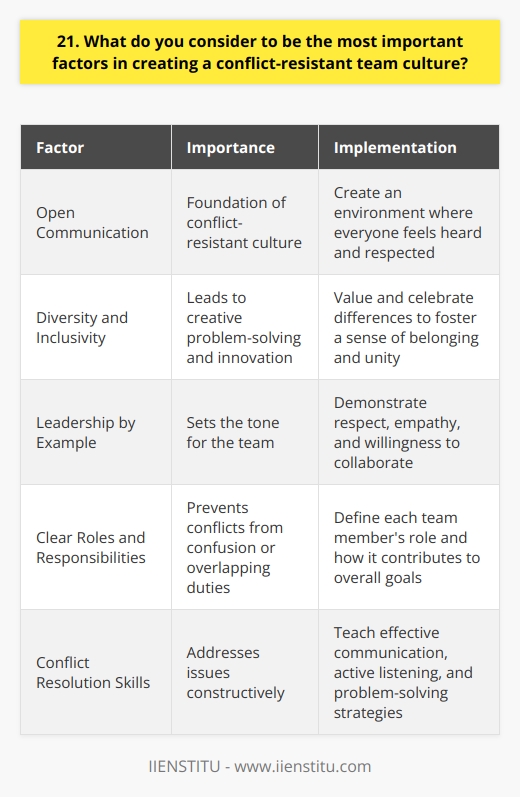
22. How do you address conflicts that arise from differences in work styles or personalities within your team?
When addressing conflicts that arise from differences in work styles or personalities within my team, I prioritize open communication and empathy. I believe that the first step is to have an honest and respectful conversation with the individuals involved to understand their perspectives and concerns.
Seek to Understand
I listen actively to each team member, asking questions to gain clarity on their unique work styles and preferences. By showing genuine interest in their viewpoints, I create a safe space for everyone to express themselves freely.
Find Common Ground
Once I have a better understanding of the situation, I try to find common ground among team members. I focus on identifying shared goals and values that can unite the team despite their differences.
Facilitate Open Dialogue
I facilitate an open dialogue where team members can discuss their challenges and brainstorm potential solutions together. I encourage them to share their ideas and actively listen to one another, fostering a collaborative problem-solving approach.
Adapt and Compromise
I recognize that resolving conflicts often requires adaptability and compromise from everyone involved. I lead by example, demonstrating flexibility in my own work style and being open to trying new approaches.
Seek Win-Win Solutions
I strive to find win-win solutions that accommodate different work styles and personalities while still achieving team objectives. This may involve finding creative ways to divide tasks, leverage individual strengths, or establish clear communication protocols.
Follow Up and Monitor
After implementing a solution, I follow up regularly with team members to ensure that the agreed-upon approach is working effectively. I remain proactive in monitoring team dynamics and addressing any new conflicts that may arise, ensuring that everyone feels heard and valued.
By approaching conflicts with empathy, open-mindedness, and a focus on collaboration, I have successfully navigated challenging team dynamics and fostered a positive work environment where diverse work styles and personalities can thrive together.
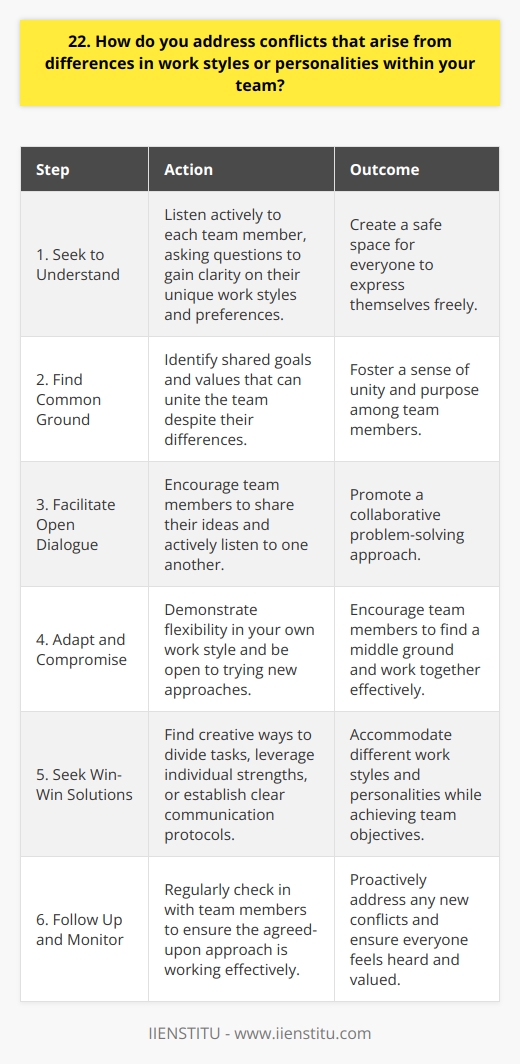
23. Can you describe a time when you had to make a difficult decision to resolve a team conflict?
In my previous role as a project manager, I faced a challenging situation where two team members had a heated disagreement over the project's direction. The conflict was causing delays and affecting team morale.
Listening to Both Sides
I scheduled separate meetings with each team member to understand their perspectives without judgment. Active listening was key to gathering insights and showing empathy for their concerns.
Finding Common Ground
After hearing both sides, I realized they shared the same goal of delivering a successful project, despite different approaches. I focused on this common ground to guide the conversation in a productive direction.
Facilitating Open Discussion
I brought the team together for an open, honest discussion. I encouraged them to express their ideas respectfully and find a mutually beneficial solution. Collaboration was emphasized over individual preferences.
Making a Decision
Ultimately, I had to make a tough call based on what was best for the project and company. I carefully weighed the pros and cons of each approach and chose the path that aligned with our strategic objectives while incorporating valuable elements from both sides.
Communicating and Implementing the Solution
I clearly communicated my decision to the team, explaining the rationale behind it. I acknowledged each member's contributions and outlined an action plan to implement the solution effectively. Regular check-ins ensured everyone was on board and progress was being made.
Through this experience, I learned the importance of active listening, finding common ground, and facilitating open communication when resolving team conflicts. Making difficult decisions is never easy, but by considering all perspectives and keeping the project's best interests in mind, I was able to navigate the situation successfully and strengthen the team's cohesion.
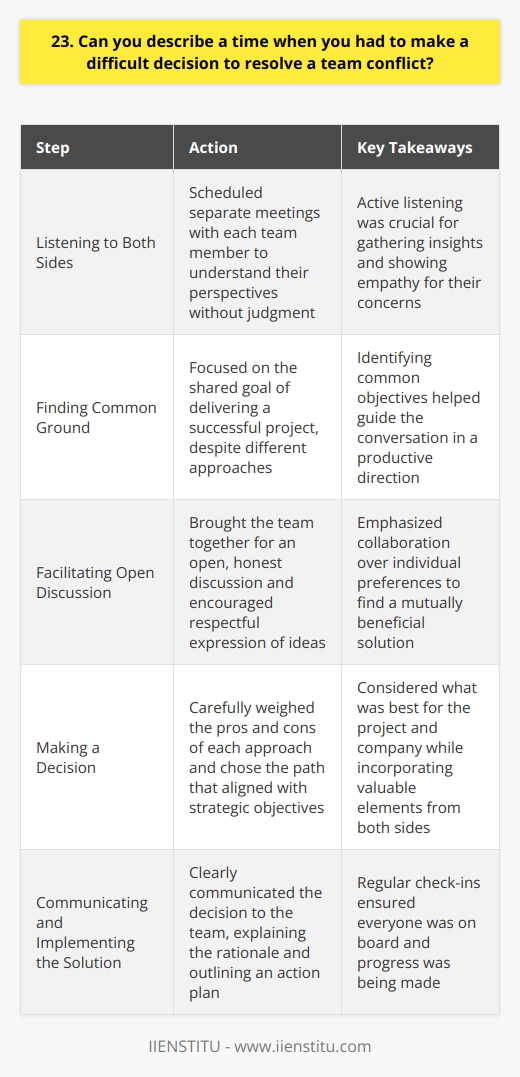
24. How do you ensure that conflicts are resolved in a way that aligns with the team's goals and values?
When conflicts arise within a team, I believe in addressing them openly and honestly. By fostering an environment of open communication, team members feel comfortable expressing their concerns and ideas without fear of judgment or retribution. This allows us to get to the root of the issue quickly and efficiently.
Focusing on Common Goals
I always try to keep the team's goals and values at the forefront of any conflict resolution process. By reminding everyone of our shared objectives, it helps to put the disagreement into perspective and encourages collaboration rather than competition. We can then work together to find a solution that aligns with our collective vision.
Active Listening and Empathy
I've found that actively listening to each person's perspective is crucial for resolving conflicts effectively. By giving everyone a chance to express their thoughts and feelings, we can gain a better understanding of where they're coming from. Empathy plays a big role here – putting myself in their shoes helps me to see the situation from their point of view.
Finding Win-Win Solutions
Whenever possible, I strive to find solutions that benefit everyone involved. This might involve compromising or thinking creatively to come up with an approach that addresses each person's concerns. By working together to find a mutually beneficial outcome, we can strengthen our team's bond and move forward with a shared sense of purpose.
At the end of the day, resolving conflicts in a way that aligns with the team's goals and values is about open communication, empathy, and collaboration. By approaching disagreements with these principles in mind, I believe we can turn conflicts into opportunities for growth and improvement.
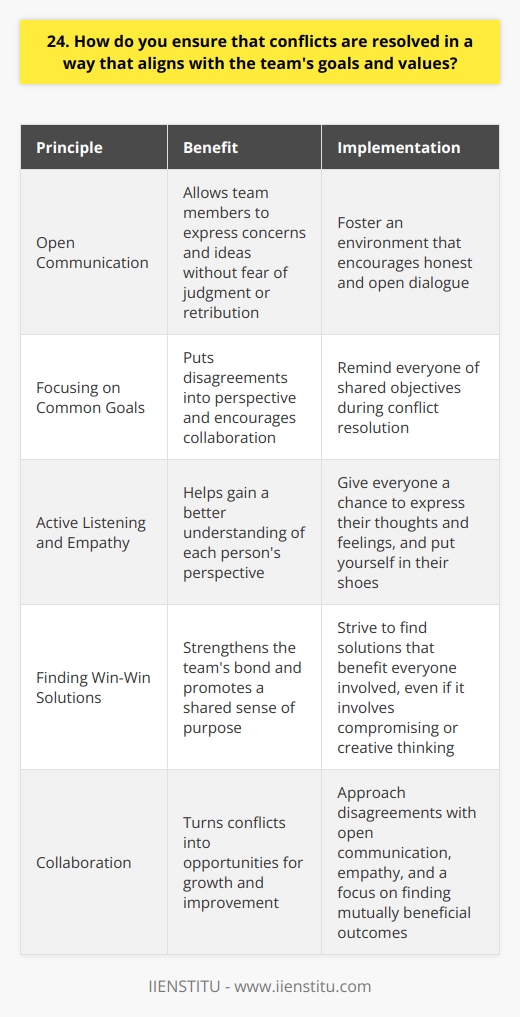
25. What strategies do you use to rebuild trust and collaboration after a team conflict has been resolved?
After a team conflict has been resolved, rebuilding trust and collaboration is crucial. I believe in taking a proactive approach to restore harmony and productivity within the team.
Acknowledge the Conflict and Its Resolution
I start by acknowledging the conflict that occurred and the steps taken to resolve it. This shows that I value the efforts made by everyone involved and am committed to moving forward positively.
Encourage Open Communication
I encourage open and honest communication among team members. I create a safe space where everyone can express their thoughts and concerns without fear of judgment or retaliation. Active listening and empathy are key in this process.
Foster a Culture of Respect and Understanding
I promote a culture of mutual respect and understanding within the team. I remind everyone that we all have different perspectives and opinions, but we share a common goal. By appreciating our differences, we can work together more effectively.
Lead by Example
As a team member, I lead by example. I demonstrate trust, collaboration, and professionalism in my interactions with others. I take responsibility for my actions and apologize if I have contributed to the conflict in any way.
Organize Team-Building Activities
I suggest and participate in team-building activities that foster camaraderie and cooperation. These activities can range from simple icebreakers to more structured events like workshops or retreats. The goal is to strengthen relationships and build a sense of unity within the team.
Celebrate Successes Together
Finally, I make it a point to celebrate the team's successes together. Whether it's a project milestone or a personal achievement, acknowledging and applauding each other's accomplishments reinforces the idea that we are a cohesive unit working towards a shared vision.
By implementing these strategies consistently and sincerely, I believe we can rebuild trust and collaboration within the team, ensuring a positive and productive work environment for everyone involved.
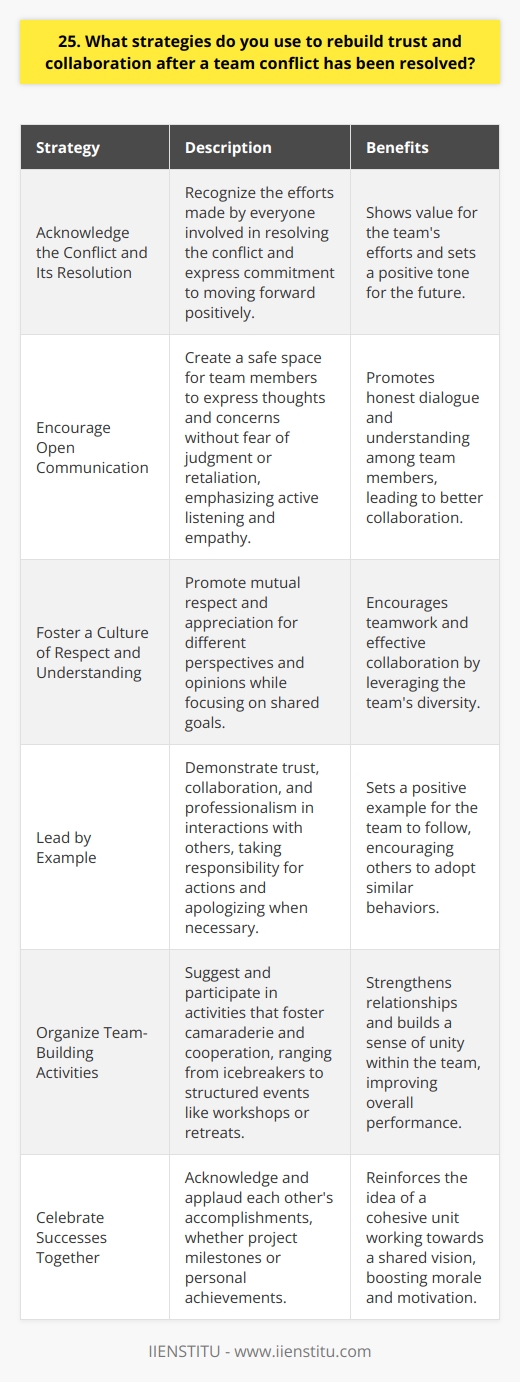
26. How do you handle conflicts that stem from resource allocation or competing priorities within your team?
When faced with conflicts arising from resource allocation or competing priorities within my team, I first seek to understand the root causes and perspectives of all involved parties. Active listening and open communication are key to identifying the underlying issues and finding common ground.
Collaborative Problem-Solving
I believe in bringing the team together to brainstorm solutions and find win-win approaches. By involving everyone in the process, we can tap into the collective wisdom and creativity of the group. This collaborative approach fosters a sense of ownership and commitment to the agreed-upon solution.
Prioritizing and Compromising
When resources are limited, it's essential to prioritize based on the most critical objectives and deadlines. I work with the team to assess the relative importance and urgency of each task, considering the overall goals and stakeholder expectations. Sometimes, compromises may be necessary to ensure the most vital priorities are addressed while finding alternative ways to support secondary tasks.
Transparent Decision-Making
Throughout the conflict resolution process, I maintain transparency in my decision-making. I clearly communicate the rationale behind resource allocation choices and how they align with the team's and organization's objectives. By being open and honest, I build trust and understanding among team members, even if they may not agree with every decision.
Continuous Improvement
I view conflicts as opportunities for growth and learning. After resolving a conflict, I reflect on the lessons learned and identify ways to prevent similar issues in the future. This may involve improving communication channels, clarifying roles and responsibilities, or establishing clearer guidelines for resource allocation. By continuously improving our processes, we become better equipped to handle future conflicts effectively.
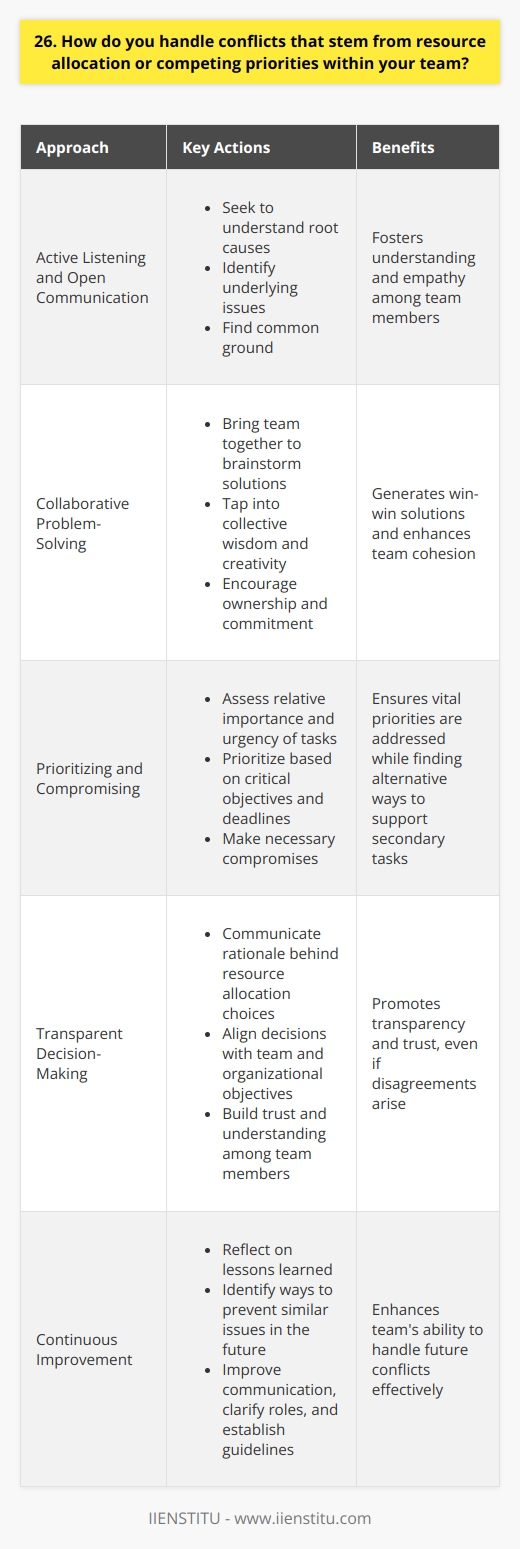
28. How do you address conflicts that may arise between your team and other departments or stakeholders?
I believe that open communication and collaboration are key to addressing conflicts between teams and stakeholders. When issues arise, I first seek to understand the perspectives and concerns of all parties involved. Active listening is crucial here.
Finding Common Ground
Once I have a clear picture of the situation, I try to find areas of agreement or shared goals. Even in the midst of conflict, there are usually some points that everyone can rally behind. Highlighting these commonalities helps build trust and goodwill.
Brainstorming Solutions
Next, I bring the relevant stakeholders together to brainstorm potential solutions. I've found that when people feel heard and included in the problem-solving process, they're much more likely to support the final decision. During these sessions, I encourage creativity and out-of-the-box thinking.
Mediating and Compromising
Of course, not every idea will be feasible or agreeable to everyone. That's where my skills as a mediator come into play. I help the group weigh the pros and cons of each option and negotiate compromises where needed. The goal is to arrive at a solution that, while perhaps not perfect for any one party, is acceptable to all.
Following Up
Finally, I believe in the importance of following up after a resolution has been reached. I check in with each team or stakeholder to ensure that the agreed-upon actions are being taken and that the conflict has indeed been put to rest. If any lingering issues remain, I address them promptly to prevent them from festering and causing future problems.
In my experience, this approach of listening, collaborating, and compromising has been highly effective in resolving cross-functional conflicts. It's not always easy, but it's always worth the effort to maintain a harmonious and productive work environment.
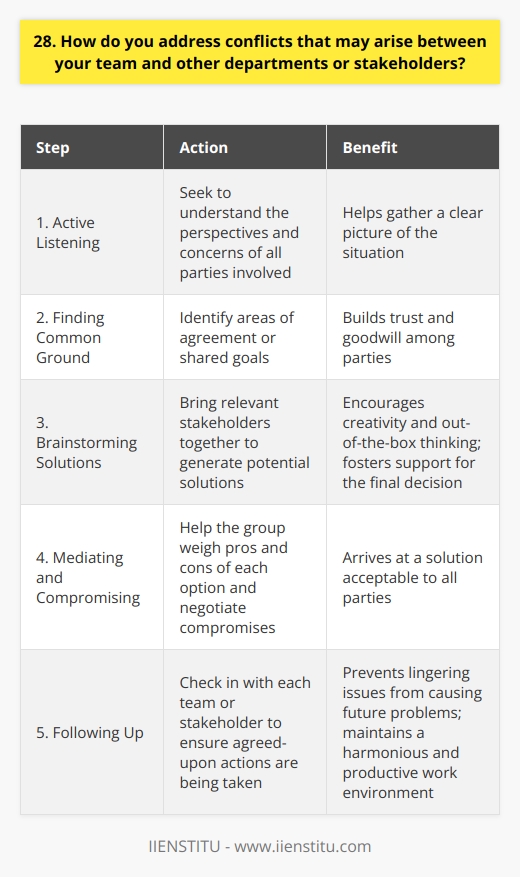
29. What do you consider to be the most important lessons you've learned about managing team conflicts effectively?
Throughout my career, I've learned that open communication is key to resolving team conflicts. When disagreements arise, I encourage team members to express their concerns and perspectives honestly and respectfully. Active listening is crucial - I make sure everyone feels heard and understood.
Finding Common Ground
I've found that focusing on shared goals helps bring people together. Even when opinions differ, reminding the team of our ultimate objectives can provide a unifying force. I try to identify areas of agreement and use those as a foundation for progress.
Leading by Example
As a leader, I believe in modeling the behavior I expect from my team. I strive to remain calm, rational, and solution-oriented during conflicts. By approaching challenges with a positive attitude and a willingness to compromise, I set the tone for constructive problem-solving.
Encouraging Empathy and Understanding
Conflicts often stem from a lack of understanding. I've learned to foster empathy by asking team members to consider situations from different viewpoints. When we take the time to appreciate each other's perspectives, it becomes easier to find mutually beneficial solutions.
Seeking Outside Guidance When Needed
In some cases, complex or deeply entrenched conflicts may require external mediation. I'm not afraid to seek guidance from HR or other impartial parties when necessary. Fresh perspectives can often help break impasses and facilitate resolution.
Ultimately, managing team conflicts effectively requires patience, adaptability, and a genuine commitment to finding win-win solutions. By prioritizing open communication, empathy, and a focus on shared goals, I strive to create a harmonious and productive team environment.

30. How do you ensure that the resolution of a team conflict leads to long-term positive changes in the team's dynamics?
When resolving team conflicts, I focus on open communication and active listening to understand everyone's perspectives. I encourage team members to express their thoughts and feelings honestly, while maintaining a respectful and professional tone. By creating a safe space for dialogue, we can get to the root of the issue and find common ground.
Identifying the Underlying Causes
I dig deeper to identify the underlying causes of the conflict, such as misunderstandings, differing priorities, or resource constraints. By addressing these root issues, we can develop targeted solutions that prevent similar conflicts from recurring in the future. It's important to look beyond surface-level symptoms and tackle the fundamental problems head-on.
Collaborative Problem-Solving
Once we have a shared understanding of the conflict, I engage the team in collaborative problem-solving. We brainstorm potential solutions together, considering everyone's ideas and concerns. By involving the entire team in the resolution process, we foster a sense of ownership and commitment to the agreed-upon changes.
Implementing Lasting Solutions
To ensure long-term positive changes, I work with the team to implement the chosen solutions. We break down the action plan into concrete steps, assign responsibilities, and set clear timelines. Regular check-ins and progress reviews help us stay on track and make any necessary adjustments along the way.
Promoting a Positive Team Culture
Beyond resolving specific conflicts, I strive to promote a positive team culture that values open communication, respect, and collaboration. I lead by example, modeling active listening, empathy, and a solutions-oriented mindset. By consistently reinforcing these values and behaviors, we can create a resilient team dynamic that prevents conflicts from escalating in the first place.
In my experience, approaching team conflicts with a combination of empathy, active listening, and collaborative problem-solving yields the best results. By addressing the root causes, involving everyone in the resolution process, and promoting a positive team culture, we can transform conflicts into opportunities for growth and strengthened relationships.
